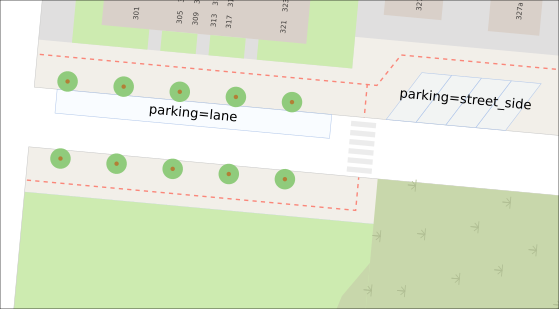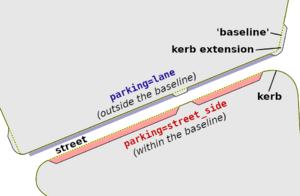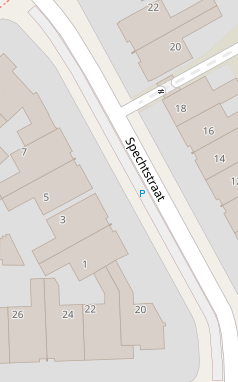Tag:parking=lane
 |
| Description |
|---|
| Parking on the carriageway, including partially on it. |
| Rendering in OSM Carto |
| Group: parking |
| Used on these elements |
| Requires |
| See also |
| Status: de facto |
| Tools for this tag |
|
This tag is used to explicitly map parking on the carriageway. Such parking areas essentially take up a part of the surface area of the road, usually with the cars parked parallel to the traffic direction; hence the tag-value lane. Such parking areas often lack explicit signage, but can be delineated by road markings.

parking=lane (left) and parking=street_side (right) parking. For illustrative purposes the highway shown here is rendered with its carriageway drawn from kerb to kerbHow to map
Draw the area where the cars can park, and tag it with amenity=parking and parking=lane.
Keep in mind though that this is a form of micro-mapping that requires a high degree of precision to be effective. Mappers may consider using the regular street parking scheme instead, where the parking area is not drawn, but implied byrelevant tags on the highway way with parking:left=*, parking:right=* or parking:both=*.
Distinction between street_side and lane parking
Street-side parking bays and areas differ more or less clearly from normal lane parking on the carriageway (parking:side=lane on the street line or parking=lane as separate feature). In general, a street_side parking area is a structural extension at the edge of the carriageway, whereas lane parking is on the carriageway itself.
However, in some cases, a distinction can be difficult and depend on the subjective perception of the mapper. For example, in many places, it is common to extend the kerb at intersections and crossings to slow down traffic and make it safer to cross for pedestrians. Those kerb extensions doesn't make a lane parking of an entire street into a street_side parking. But if there are many kerb extensions in one street, it may become a little hard to distinguish between these two situations in reality.
The following criteria can help to make a classification: they do not have to be fulfilled individually, but can facilitate a categorisation when combined.
Note: When mapping the carriageway width (width=* on the highway line), be aware that the carriageway width includes lane parking areas, but never includes street-side parking areas.
Characteristics indicating street_side parking
Characteristics indicating lane parking
Kerb Extensions

Particularly in combination with kerb extensions (also called "bulb out", "neckdown" and similar), it can be unclear whether a parking area is considered street-side or lane parking. Kerb extensions are traffic calming measures which widens the sidewalk for a short distance to increasing traffic safety for pedestrians.
Kerb extensions are often built into existing road cross-sections. Whether or not this turns a former lane parking into a street-side parking in the OSM sense must be considered in each individual case. The characteristics mentioned above or the following principles can help:
- Large distances between the pavement extensions, the absence of fixed obstacles such as trees, lampposts or bollards as well as an unchanged road surface in the parking area tend to indicate the category of
laneparking. - If, on the other hand, the parking area is divided into rather short sections that are clearly separated from the roadway, this indicates
street_sideparking. - Kerbs form a line that separates the carriageway from the roadside space. Kerb extensions and the parking area in between usually extend out from this "baseline", while street-side parking areas fall behind this "baseline" (see illustration on the right).
Also note the remark above about carriageway width if this is specified at the highway line: For lane parking, the parking area is part of the width value, whereas for street-side parking it's not.
Rendering
Rendering in most cartographic styles follows that of other amenity=parking types such as parking=surface.
In OpenStreetMap Carto, the blue P is rendered slightly smaller than that of larger parking features:

See also
- Street parking – Parking along streets. Places on the tracks where cars are allowed to park
parking=street_side– Area suitable or designated for parking, which is directly adjacent to the carriageway of a road and can be reached directly from the roadway without having to use an access way








